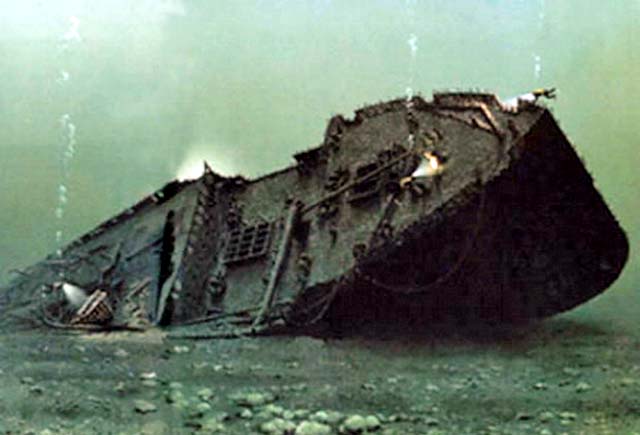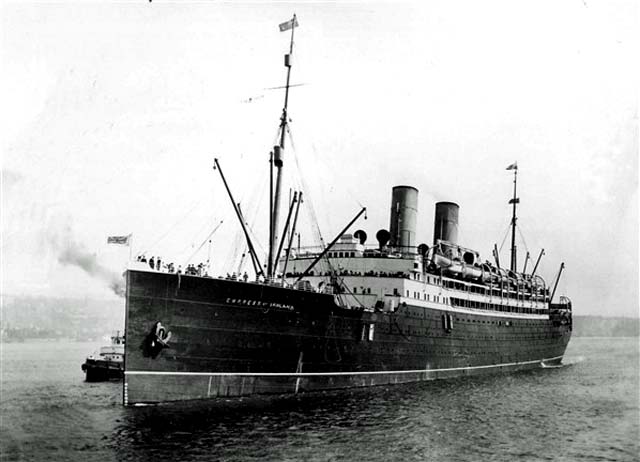
2012
|


An artist's illustration shows how the Empress looks today - Date/Artist unknown.
29 February 2012
The Wreck of the Empress of Ireland
Rimouski Quebec - On its 100th anniversary, the sinking of the Titanic continues to fascinate people around the world. But another
shipwreck, almost equal in human tragedy, has slipped from popular memory, even though the vessel helped build modern Canada.
The Empress of Ireland sank in 1914 in the St. Lawrence River after colliding with the Storstad, a Norwegian coal ship. A total of 1,012 passengers and crew
died (compared to the Titanic's 1,514).
The loss of the Empress of Ireland remains the largest maritime accident in Canadian history.
Unlike the Titanic, which went down on its maiden voyage, the Empress of Ireland regularly plied the Atlantic Ocean. Between 1906 and her sinking, the Empress
completed 95 round trips, mostly between Liverpool, England, and Halifax or Quebec City. She was one of two Canadian Pacific ships, her sister ship was the
Empress of Britain, plying the Atlantic between the United Kingdom and Canada, bringing thousands of immigrants, mostly drawn by the prospect of free land on
the Prairies.
For years, the remains of the Empress lay on the river bottom off Rimouski, Quebec, where it was picked over by souvenir-hunting divers. It was designated a
national historic site in 1988, but it wasn't until 11 years later that the Quebec government tightened regulations to stop souvenir collecting. A small museum
dedicated to the Empress now operates in Rimouski for half the year.
As the 100th anniversary of the sinking approaches, a Central Saanich man who owns a collection of 120 artifacts from the Empress of Ireland, perhaps one of
the largest in private hands, wants Canadians to learn more about the ship, not just because of its tragic sinking, but for the huge role it played in forming
modern Canada, bringing immigrants who mostly settled in the West.
Chris Klausen, 51, says about 500,000 Canadians are descendants of passengers who arrived on the Empress of Ireland. "It is such an important part of
settling Canada," Klausen said. "And Canada, being so influenced by Britain and so influenced by what goes on in the United States, here's your
Titanic.
"Embrace it, teach kids, teach people."
The day before the tragic 29 May 1914 sinking, the Empress of Ireland had left Quebec City, bound for Liverpool. Sailing in fog, she was struck near Rimouski
by the Storstad, which sliced an enormous gash in the starboard side of her hull.
Water rushed in and the ship listed severely, allowing more water to rush in through open portholes. With the ship on its side, some survivors squeezed out of
portholes on the opposite side of the ship. But most passengers were trapped inside and died.
The sinking took about 14 minutes.
According to author Derek Grout in "Empress of Ireland, The Story of an Edwardian Liner", those 14 minutes would make few people proud.
"There were no gentlemanly cries of Women and children first!" Grout wrote. "In the dark of night, it was a free-for-all and surviving the
Empress was, at best, a matter of luck."
A board of inquiry would later blame the crew of the Storstad for the collision. But Norwegian authorities conducted their own investigation and disputed those
findings. A Canadian documentary, "The Last Voyage of the Empress", re-enacted the collision and concluded the fog was mostly to blame, but Empress
captain Henry Kendall was not without fault.
A salvage operation shortly after the collision recovered the ship's mail and 212 bars of silver, worth about $1.1 million today.
Within months of the sinking, the First World War was underway, and the thousands of men dying in trenches every day soon overshadowed the casualties of the
Empress of Ireland.
Some believe Canadian Pacific wanted to keep things quiet. With ships on the Atlantic, a railway and hotels spanning Canada, and more ships on the Pacific, it
was possible to circumnavigate the globe without leaving the care of CP. So the company was reluctant to air details of the sinking.
Jacques Marc, exploration director with the Underwater Archeology Society of B.C., noted the company also lost the Princess Sophia off B.C. (It sank in 1918 in
Lynn Canal near Juneau, Alaska, killing 343 people.)
"CPR as a company doesn't want to bring up that history at all," Marc said.
In 1971, David Brinnin, an American poet, literary critic, and travel writer, dismissed the significance of the Empress of Ireland wreck. Brinnin wrote that
the dead were nothing better than "a lot of middle-class Anglo-Saxons, a long roster of Salvation Army officers, and executives from one end of Canada to
the other."
So in 1998, when maritime historian David Zeni published his book on the ship, he titled it "The Forgotten Empress".
A few small tales have lived on, however.
According to James Croall, writing in the 1978 book "Fourteen Minutes", the ship's cat, a yellow tabby of "doubtful antecedents," fled down
the gangway just as the ship was leaving. A steward ran after him and brought the cat back, but again the animal bolted and was left behind.
The ship also has a Vancouver Island connection. Ship's doctor James Grant, born in Wellington, now a suburb of Nanaimo, survived the sinking. "Fourteen
Minutes" tells how Grant distinguished himself tending survivors pulled on board the Storstad, setting limbs, and treating injuries while wearing a pajama
top and borrowed trousers.
Grant later returned to practise and live in Victoria and died in 1947. Even his children apparently knew little of his moment on the doomed ship. According to
a 1982 article in the Canadian Medical Association Journal, Grant's daughters said they had never heard him discuss the Empress of Ireland.
When Klausen first heard about the Empress, he was still living in his native U.S., where he grew up on Long Island, New York, sailing every summer and digging
clams for a summer job.
Klausen said he had always been interested in the sea, maritime history, and in particular, the Titanic story.
Then, Klausen said, he read something about the Empress of Ireland and found the story every bit as compelling as the Titanic's.
"I thought, How is it possible that I don't even know about this?"
He contacted marine divers who had been to the wreck, retrieved artifacts and were selling them, and started his own collection.
He later married a Canadian woman and was surprised to find that even she had never heard of the Empress of Ireland. After moving here, he was even more
stunned to learn so few Canadians knew of it.
"I'm like, How can this be possible that nobody really knows about it? This is something that should be taught in schools," he said.
Now, with the 100th anniversary of the sinking approaching in 2014, Klausen said he would like to see his collection and any other artifacts from the Empress
of Ireland packaged and taken on a tour of Canada.
Klausen is convinced the reaction would be positive.
"People are usually thankful, thinking that the story is going to get out. Finally Canada is going to know about this tragedy," said Klausen.
"It's amazing the emotion, even when it's for people they didn't even know," he said. "This really is Canada's Titanic."
Richard Watts.

The Empress of Ireland was built on the Clyde by Fairfield SB & E Co., and measured 14,191 GRT, 570 feet LOA, 548
feet 10 inches BP, 65 feet 9 inches beam. Twin screws, powered by 2 four-cylinder quadruple expansion engines, producing 3,168 nhp, providing a service speed
of 18 knots. She had accommodation for 310 first class, 500 second class, 500 third class, and 270 steerage passengers.

|


